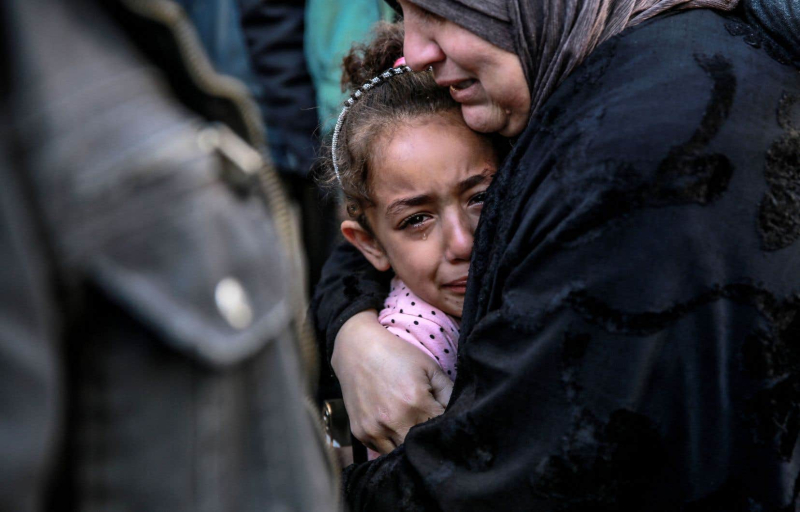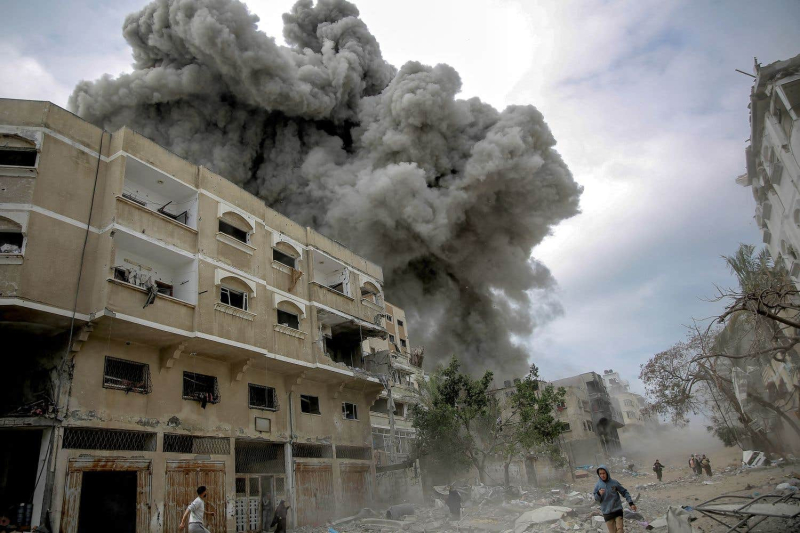
Photo: Agence France-Presse A Palestinian woman and child mourn their loved ones killed in an Israeli bombing outside the morgue of al-Shifa hospital in Gaza on March 15, 2024.
Zacharie Goudreault
March 18, 2024
- Middle East
The challenges of supplying humanitarian aid in the Gaza Strip, besieged by Israel, have caused an unprecedented food crisis there, according to two experts consulted by Le Devoir. Meanwhile, the hope of a ceasefire remains slim, and the Israeli army attacked the country's main hospital on Monday, where it claimed to have killed 20 Hamas fighters.
“Gaza was, before the war, the largest open-air prison. Today, it is the largest open-air cemetery for tens of thousands of people, but also for many of the most important principles of humanitarian law,” declared Monday the head of European diplomacy, Josep Borrell, shortly before the start of a meeting of European Union foreign ministers.
One in two inhabitants of the territory, or more than 1.1 million people, experiences a “catastrophic” food situation, particularly in the north, where famine will rage by May in the absence of “urgent” measures, they said. notified the specialized UN agencies.
Also read
- Netanyahu promises to evacuate the population before any operation in Rafah
- Hopes for a truce revived in Gaza, first aid boat unloaded
- US Senate Democratic leader calls for elections in Israel
“Famine is no longer a risk, it’s a reality”, notes for his part in an interview with Le Dutyprofessor in the Department of Sociology at the University of Quebec in Montreal and specialist in conflicts in the Middle East Rachad Antonius. The latter shares the analysis of Mr. Borrell, who declared on Monday that “we are no longer on the verge of famine, we are facing a famine that affects thousands of people” in Gaza. However, “hunger cannot be used as a weapon of war”, he recalled, before urging Israel to authorize “free, unhindered and safe humanitarian access” to this Palestinian territory.
Gaza is facing famine. According to @theIPCinfo, 100% of people are acutely food insecure; in the North, 70% are facing famine. Hunger can’t be used as a weapon of war.
W/@JanezLenarcic, we urge Israel to allow free, unimpeded, safe humanitarian access.https://t.co/1DAMzG5G3t
— Josep Borrell Fontelles (@JosepBorrellF) March 18, 2024
Faced with the humanitarian emergency, several countries have organized airdrops, which have become daily, and opened a maritime corridor from Cyprus, but all emphasize that these supply routes cannot replace land routes, of which Access to the Gaza Strip remains severely limited following restrictions imposed by Israel. These are “hundreds of trucks” carrying “months of stocks” of food and humanitarian aid which are waiting in vain to enter the Gaza Strip, due to lack of authorization by the Israeli authorities, noted Josep Borrell.
Sami Aoun, professor emeritus of political science at the University of Sherbrooke, believes that the Gaza Strip has never experienced a food and humanitarian crisis of such magnitude as the one its residents are currently experiencing. “This is the first time in Gaza that we have had a state of siege and massive destruction of infrastructure to the point of making the Gaza Strip so inhospitable,” underlines the expert, in an interview with The Duty. He describes the famine raging in this territory of 2.4 million inhabitants as a “tragedy on a large scale”.
A hospital targeted
The Israeli army also claimed on Monday to have killed around 20 Palestinian fighters and arrested more than 200 others during a large operation against the largest hospital complex in the Gaza Strip, al-Shifa, which pushed hundreds civilians to flee the area. “We destroyed the vast majority of hospitals in the region,” sighs Rachad Antonius, according to whom the heavy toll of civilian victims in Gaza shows that Israel is currently not waging a war against Hamas, but “against the Palestinians”. 60~/p> 
Photo: Agence France-Presse Downtown Gaza was hit hard by Israeli bombardments on Monday.
According to the Hamas Health Ministry, more than 31,700 people have been killed in Gaza since Israel began a violent response to the October 7 attack by Hamas militants on its territory. This left 1,160 dead.
“Israel's main goal is for Palestinians to leave and integrate with other countries,” continues the expert, thus calling into question the argument that Israel is bombing Gaza for months in “self-defense.” The Director General of the World Health Organization, Tedros Adhanom Ghebreyesus, for his part recalled on Monday that hospitals “should never be battlefields”, in a publication on the social network “the establishment jeopardizes health services, access to ambulances and the delivery of vital supplies,” he added, before calling for a “ceasefire” in Gaza.
Hospitals should never be battlegrounds. We are terribly worried about the situation at Al-Shifa Hospital in northern #Gaza, which is endangering health workers, patients and civilians.
The hospital has only recently restored minimal health services. Any hostilities or…
— Tedros Adhanom Ghebreyesus (@DrTedros) March 18, 2024
Israeli Prime Minister Benjamin Netanyahu, for his part, spoke with the American president on Monday. In a press release, he said he had assured Joe Biden that his country was determined to “achieve all the objectives of the war in Gaza”, including “the elimination of Hamas” and the release of the 130 Israeli hostages who are still there. in this Palestinian territory.
Joe Biden, who supports Israel almost unconditionally since the unprecedented attack perpetrated by Hamas in Israel on October 7, is increasingly distancing himself from Benjamin Netanyahu. He recently declared that the Israeli prime minister was “doing more harm than good” to his country with his conduct of the war in Gaza, where the human toll continues to rise and the catastrophic humanitarian situation continues. to get worse.
An improbable “boycott”
The United States nevertheless continues to be Israel's main arms supplier, alongside Germany and the United Kingdom. Canada, for its part, on January 8 stopped agreeing to the export of non-lethal military equipment such as vehicles and electronic equipment, particularly to Israel, due to the humanitarian crisis in Gaza. However, Canadian military exports to the Jewish state have seen significant growth over the past 10 years, according to data from Global Affairs Canada.
“Israel is a privileged ally of the United States, Canada and European NATO member countries,” recalls Sami Aoun. It is therefore unlikely that these states, even if they criticize the scale of the attacks carried out by Israel in Gaza, will go so far as to “carry out a boycott and completely cut off the flow of weapons” to this country, believes the professor. emeritus of the University of Sherbrooke, since this would mean that their relationship with the Jewish state “is greatly disturbed”.
The UN criteria for declaring a famine
The UN, which fears a famine in northern Gaza by the end of May in the absence of “urgent” measures, uses strict criteria to declare a famine in a specific territory. It is based on its specialized agencies based in Rome, the World Food Program (WFP) and the Food and Agriculture Organization, which rely on a technical body, the Integrated Food Security Classification Framework ( CPI). According to its latest report, published Monday, one in two Gaza residents is currently in a “catastrophic” food situation, or 1.1 million people.
The “starvation” category represents the highest severity phase of the IPC acute food insecurity scale, which has five stages: phase 1 (“minimal”), phase 2 (“stress”), phase 3 (“crisis”), phase 4 (“emergency”) and finally, phase 5 (“disaster/famine”).
Phase 5 is reached when a territory meets these three criteria:
- at least 20% of households face an extreme lack of food;
- at least 30% of children suffer from acute malnutrition;
- at least 2 people in 10,000 or at least 4 children under 5 in 10,000 die every day from starvation or due to malnutrition-disease interaction.
Concerning this third criterion, mortality “is accelerating, but the available figures are limited, as is often the case in war zones”, according to the WFP. However, “waiting for confirmation that a famine is in progress […] before taking radical measures is indefensible,” indicates the IPC in its report.
Once the criteria determined by the IPC have been met, it is up to relevant stakeholders at the country level, such as government authorities and UN agencies, to declare a famine. The last famines declared by the UN date back to 2017 in South Sudan and 2011 in Somalia.
Gildas Le Roux, Agence France-Presse
With Agence France-Presse

